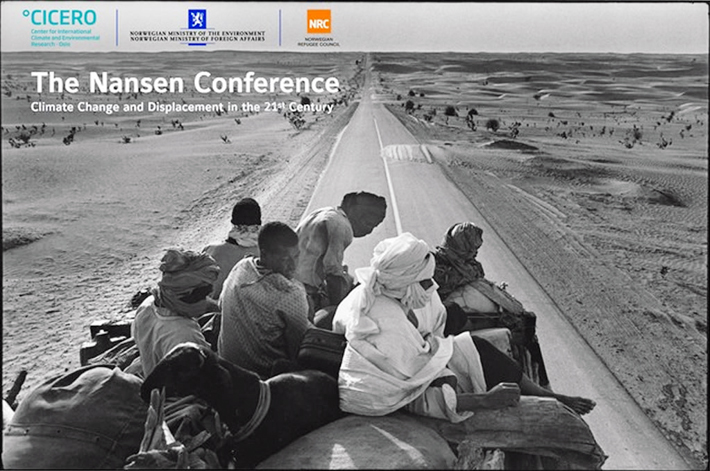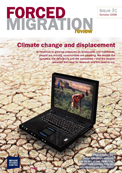Posted by Dan DaSilva on May 30th, 2011 | 
 The Nansen Conference on Climate Change and Displacement in the 21st Century will convene in Oslo, Norway from Monday, June 6 to Tuesday, June 7, 2011. The meeting is hosted by the Ministry of the Environment and the Ministry of Foreign Affairs. The Nansen Conference on Climate Change and Displacement in the 21st Century will convene in Oslo, Norway from Monday, June 6 to Tuesday, June 7, 2011. The meeting is hosted by the Ministry of the Environment and the Ministry of Foreign Affairs.
This conference will focus on vulnerability, resilience and capacity for adaptation of
communities in areas that are prone to disaster due to climate change, the protection of displaced people, and promotion of action to help prevent or manage displacement. The conference also aims to provide up-to-date projections with regard to drivers of displacement such as drought, floods, storms and sea-level rise.
Click here for the conference
website.
Click here for the preliminary program.
Posted by Kayly Ober on May 24th, 2011 | 
Again, thanks to Forced Migration Current Awareness, we learned of a series of podcasts that deal with environmentally-induced migration :
Stephen Castles Speaks on Climate Refugees (BBC, May 2011) [access]
“Environmental Refugee” Not Accurate
for Pacific (Radio Australia, May 2011) [access]
Tuvaluans Don’t Want to be Called Refugees (Radio Australia, May 2011) [access]
Many thanks, fm-cab!
Posted by Kayly Ober on May 24th, 2011 | 
Thanks to Forced Migration Current Awareness we learned of a special issue of International Migration that focuses on environmentally-induced migration.
Contents include the following:
Download each article free here.
Posted by Kayly Ober on May 20th, 2011 | 
(IRIN) May 20, 2011 – For centuries, residents around Can Tho, a city of
1.1m people in southern Vietnam, just 0.8m above sea level, have depended on flood cycles to grow crops.
However, experts warn there is a possibility that sea levels will rise in the delta region around Can Tho due to climate change, causing devastating floods that will displace millions and destroy those crops.
Can Tho is in the wider Mekong Delta, a rice-growing region that spans southern Vietnam and is home to 18 million people. More than half of Vietnam’s rice is produced in the delta, as well as 60 percent of its fish and shrimp.
A 1m sea-level rise could displace more than seven million residents of the Mekong delta, and a 2m sea-level rise could double that number, according to a study by the Columbia University Center for International Earth Science Information Network in New York, the UN Refugee Agency (UNHCR), and other groups.
The delta is where the Mekong River divides into nine channels after a 5,000km journey from the Tibetan plateau. It is “particularly susceptible” to sea-level rises, says Alex de Sherbinin, a senior research associate at the Columbia University Center. A 1m sea-level rise is “definitely within the bounds” of happening this century, he told IRIN. A 2m sea-level rise, however, is less likely.
The study examined the major deltas of the world, and was based on current patterns of climate change and migration for glacier melt, as well as interviews with displaced residents.
According to the Fourth Assessment Report of the Intergovernmental Panel on Climate Change (IPCC), considered the most authoritative group on the topic, millions of people in deltas in Vietnam, Bangladesh and Egypt will be directly affected by sea-level rises by the end of this century.
Continue reading this post »
Posted by Kayly Ober on May 13th, 2011 | 
(The Guardian) May 11, 2011 – Imagine if the world acted only when 100% scientific proof was in place.
We would still be insulating buildings with cancer-causing asbestos and fuelling cars with lead additives, damaging babies’ brains. The circulation in fridges would also be done by chemicals that, by thinning the Earth’s protective ozone layer, would probably have led to a sharp increase in cases of skin cancer worldwide.
But this is not happening. In those cases, governments assessed the emerging science, consulted on the risks and accepted that the evidence outweighed the uncertainties.
Internationally, it is called the precautionary approach: you and I might call it acting responsibly, prudently or just being smart.
Climate change perhaps triggers some of the most polarised debate between precaution and those who say that without scientific perfection it is all just hot air.
This has re-surfaced in recent weeks over the issue of climate change and migration.
Continue reading this post »
Posted by Kayly Ober on April 25th, 2011 | 
(The Ecologist) April 18, 2011 – While scientists and the international community endlessly debate and argue, millions of Bangladeshi citizens have already been displaced by climate change – for them the worst-case ‘nightmare’ climate scenario is already real
Climate displacement has arrived without mercy in Bangladesh. In Khulna district alone, some 60,000 Bangladeshi citizens have fled what has become permanent coastal flooding in the remote southwest of the country. With no option of returning home, and little access to new land thus far, these climate displaced persons (CDPs) are forced to survive on a 25 kilometre long, 2m high and 3-4 m wide embankment.
This desperate community in Dacope sub-district in Khulna has built rudimentary, makeshift shelters along the length of the levee that was originally designed to protect their now destroyed villages, land and homes. The levee failed, and all they now have are insecure and instable shelters perched precariously atop the embankment, surrounded by unruly water on both sides at high tide and at low tide by thousands of hectares of desolate muddy land that was once fertile paddy and farmland.
Living in this isolated and impoverished corner of Bangladesh, which borders on the famous Sundarban National Park, and completely segregated from political life in Dhaka (and the officials that could assist them in finding new land), the people of the delta see all too little hope or viable options for the future. Ninety-per cent of the CDPs are now without livelihoods, forced to live day by day from aid handouts and are unable to return to lives, land and homes that were completely obliterated by coastal erosion and storm surges. Nor do the displaced in Dacope see any solutions coming from the Government of Bangladesh any time soon, with officials seeming thus far resistant to suggestions that they may need to assist this and other climate-affected communities to relocate to safer areas and provide them with new land.
Continue reading this post »
|
|
 The Nansen Conference on Climate Change and Displacement in the 21st Century will convene in Oslo, Norway from Monday, June 6 to Tuesday, June 7, 2011. The meeting is hosted by the Ministry of the Environment and the Ministry of Foreign Affairs.
The Nansen Conference on Climate Change and Displacement in the 21st Century will convene in Oslo, Norway from Monday, June 6 to Tuesday, June 7, 2011. The meeting is hosted by the Ministry of the Environment and the Ministry of Foreign Affairs.


